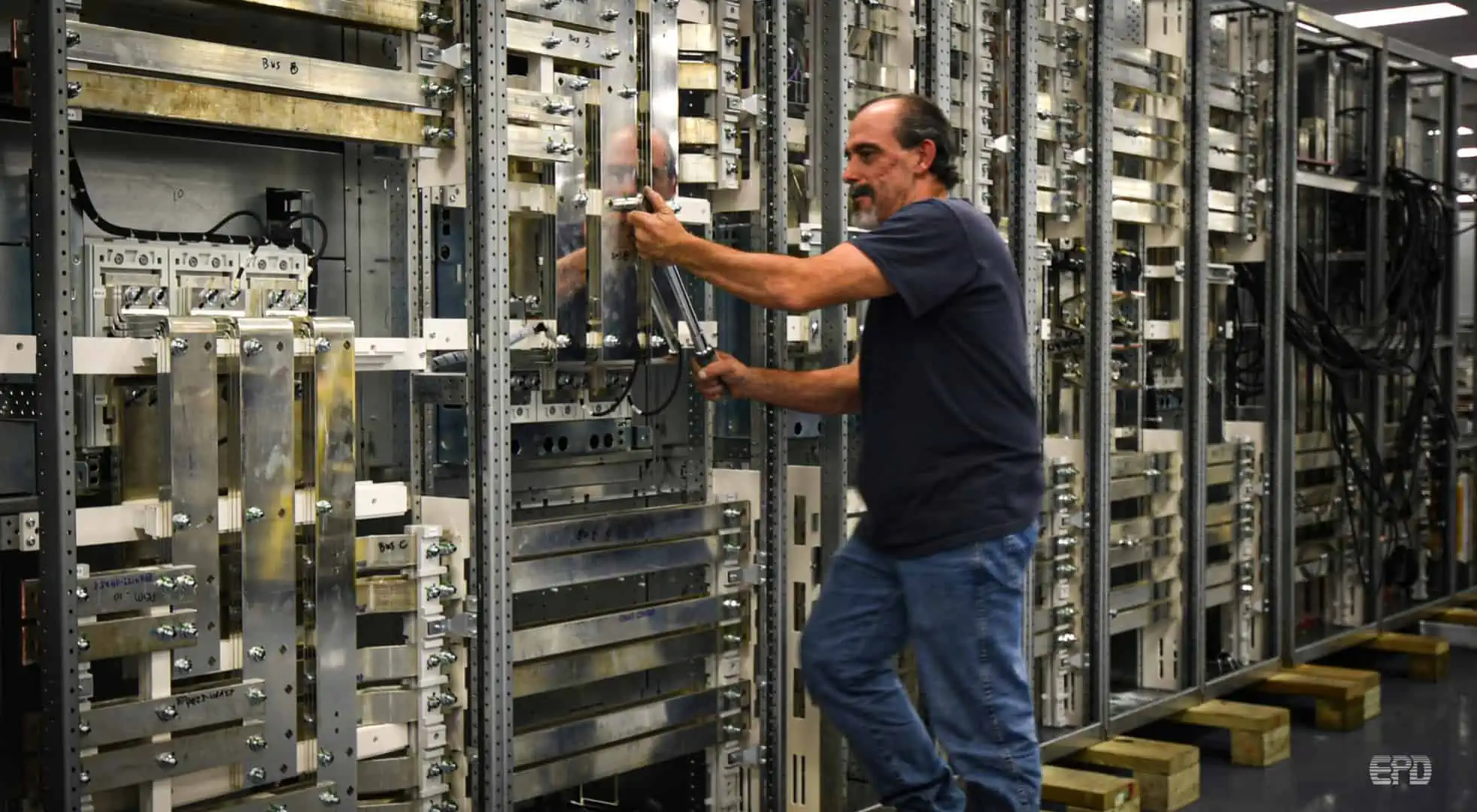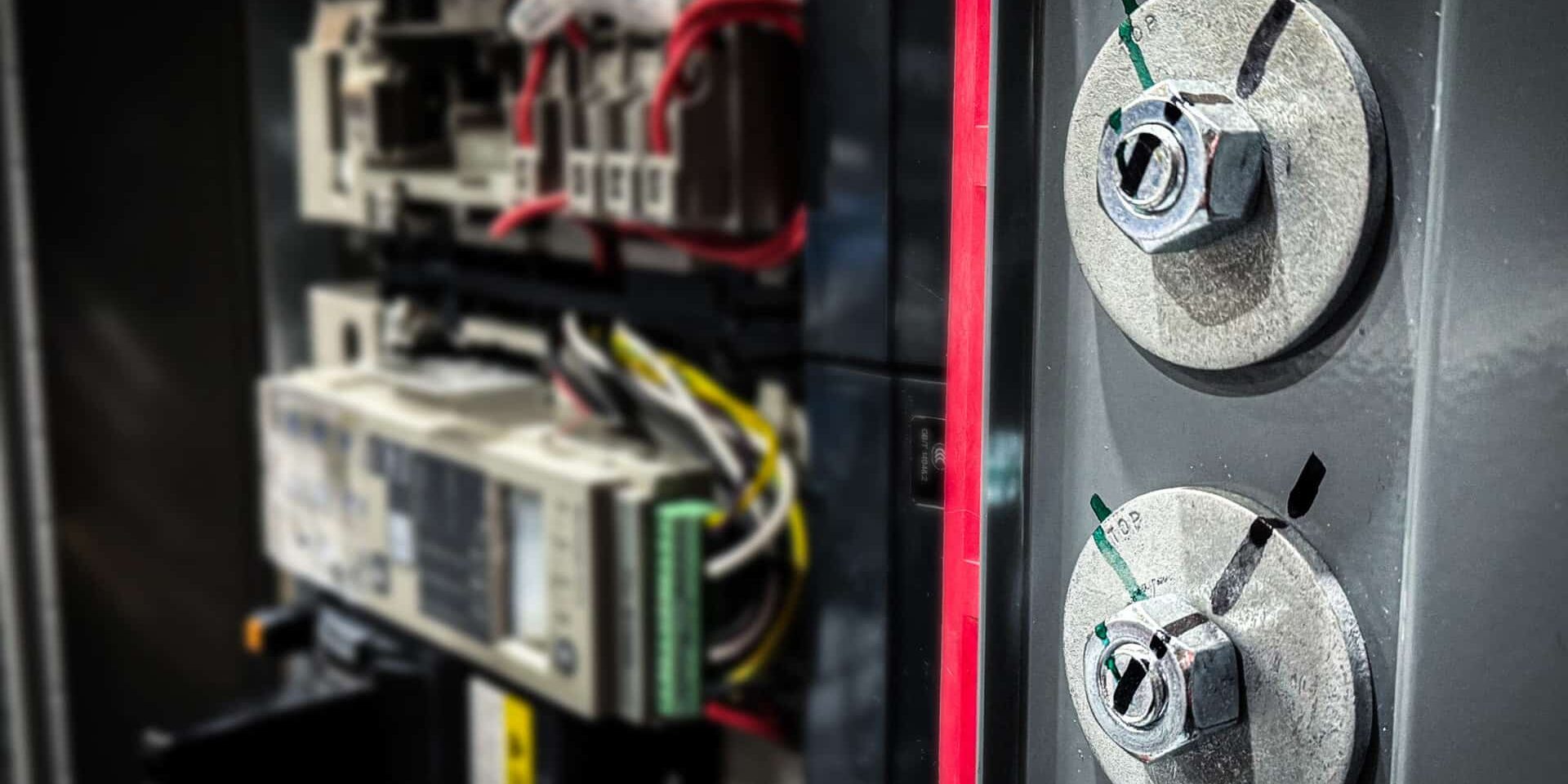Switchboard Maintenance: Safeguarding Your Electrical System’s Longevity
The Importance of Switchboard Maintenance
Keeping a switchboard in decent shape requires more than just having reliable power. It is also about ensuring safety and longevity for your electrical systems.
Unexpected equipment failures or production shutdowns cost manufacturers $50 billion annually and significantly raise long-term maintenance costs. According to Article 408 of the National Fire Protection Agency’s (NFPA) National Electric Code (NEC), regular inspections are key to identifying minor issues early on and mitigating risks before they become major problems.
March 1, 2024

Efficient Power Flow: Essentials of Switchboard Maintenance
Have you ever been in a high-stakes game where every move counts? Professional electrical contracting can be felt the same way, as every component in an electrical system plays a pivotal role in ensuring smooth, safe operations.
The tension when a critical component falters is akin to the imminent collapse of a carefully constructed Jenga tower.
Just like the nerve-wracking moment in a game where your strategic moves determine your fate, potential switchboard malfunctions induce a similar pulse-quickening experience.
Dealing with unexpected equipment failures or production shutdowns is stressful.
Failures significantly impact operational efficiency and can be costly to fix.
So, why wait for a crisis to unfold when you can prepare in advance?
This article covers proactive strategies to ensure your operations continue with minimal interruption by actively maintaining voltage switchboards.
Contact our team of experts at Electronic Power Design (EPD) to learn how we can help.
Table of Contents:
- The Importance of Switchboard Maintenance
- Benefits of Regular Inspections
- Switchboard Components and Standards
- Understanding Switchboard Standards
- The Impact of Vibrations on Switchboards
- Preventative Maintenance Procedures for Switchboards
- Testing and Inspections for Switchboards
- Insulation Resistance and High Potential Capability Tests
- Best Practices in Switchboard Maintenance
- Importance of Record Keeping in Maintenance
- Role of Qualified Personnel in Maintenance
- Impact of Proper Switchboard Maintenance on Production Efficiency
- Switchboard Maintenance FAQs
- How Do You Maintain a Switchboard?
- What Is the Service Life of a Switchboard?
- How Often Should Switchboard Maintenance Be Done?
- When Should a Switchboard Be Replaced?
- In Summary
The Importance of Switchboard Maintenance
Keeping a switchboard in decent shape requires more than just having reliable power. It is also about ensuring safety and longevity for your electrical systems.
Unexpected equipment failures or production shutdowns cost manufacturers $50 billion annually and significantly raise long-term maintenance costs. According to Article 408 of the National Fire Protection Agency’s (NFPA) National Electric Code (NEC), regular inspections are key to identifying minor issues early on and mitigating risks before they become major problems.
Benefits of Regular Inspections
Frequent check-ups help spot small hiccups like insulation resistance drops or control wiring wear-out before they escalate into catastrophic failures such as circuit breaker malfunctions or voltage switchboards overheating.
Inspections help maintain electrical equipment and significantly reduce the chance of unplanned downtime due to faulty components.
This specifically applies to low voltage switchboards, which play an essential role in effectively distributing electrical power across systems used widely in hospitals, data centers, and many other commercial industries.
Switchboard Components and Standards
A switchboard is a complex electrical device for distributing power in electrical systems. Specifically, switchboards direct electricity from one or more sources to other, smaller endpoints.
Understanding Switchboard Standards
In power distribution, rules are meant to be fixed. Rather, they ensure safety and efficiency. NEC 408 provides guidelines on switchboard construction with the goal of minimizing the potential hazards of improper setup and maintenance, such as fires or electrocution.
The Impact of Vibrations on Switchboards
Minor vibrations in electrical systems may seem insignificant. However, sensitive electrical components like nut bolts in busbar connections can cause serious issues.
If left unchecked, these vibrations can loosen connections, resulting in overheating, sparks, and even fire. Operations teams should always take any observed switchboard vibrations seriously and implement maintenance protocols immediately.

Preventative Maintenance Procedures for Switchboards
Switchboards are the heart of electrical systems. Like any vital organ, they need regular check-ups to stay in decent shape. Preventative maintenance for switchboards will keep parts running smoothly and safely. Maintenance includes:
- Checking Fastenings: Tightening loose fastenings on residual current devices and circuit breakers can help prevent potential vibration hazards caused by connections loosening over time.
- Cleaning Busbars: Before undertaking any cleaning procedures, it is advisable to consult with experts in the field and, if possible, refer to the equipment manufacturer's guidelines. Cleaning could be required in some circumstances, but it should be done carefully to prevent unforeseen results. A deeper comprehension of the circumstances and kinds of impurities that might affect busbar performance is required.
To effectively distribute electrical power without interruption, these steps should be part of your routine maintenance schedule. Always ensure this work is done by trained professionals who understand the safety switches and standards set for working with voltage switchboards.
Testing and Inspections for Switchboards
In addition to maintenance, switchboards also require regular testing and inspection.
Insulation Resistance and High Potential Capability Tests
Testing the insulation resistance of a switchboard is an essential part of keeping it sturdy. This technique evaluates the insulation materials of the equipment and provides a safeguard against future unforeseen failures or potential risks.
HiPot tests, also known as high-potential capability tests, are an important part of your maintenance toolbox. These tests help guarantee a dependable power supply when it is most required by making sure that no current moves from one place in an electric circuit to another.
Although these tests are necessary in some situations, it is vital to remember that they are usually conducted at the manufacturer's location prior to the switchboard being sent.
Moreover, commissioning teams usually repeat these tests prior to switchboard energization.
It might only be required to include these tests in routine inspections if the user is upgrading or making significant changes to their switchboard.
To choose the best maintenance procedures for your circumstance, it is important to take the context into account and speak with professionals.
Best Practices in Switchboard Maintenance
Maintaining your switchboards is not a one-off endeavor but rather an ongoing activity. Let us discuss some key practices to keep them in decent shape.
Importance of Record Keeping in Maintenance
The first step towards effective maintenance is thorough record keeping.
Every inspection and repair should be documented. This helps track the switchboard’s health over time and identifies recurring issues or spare parts requiring frequent replacement.
Role of Qualified Personnel in Maintenance
Safety comes first when dealing with electrical equipment like voltage switchboards. Therefore, only qualified personnel should perform maintenance tasks.
Qualified personnel will have the necessary skills to perform insulation resistance testing and identify faulty components before they cause a production shutdown or equipment failure.
Additionally, make sure you maintain an adequate stock of essential switchboard spare parts and conduct regular testing on overcurrent protective devices and safety switches according to applicable safety standards. Regular cleaning to prevent buildup is also a part of this ongoing maintenance.
Impact of Proper Switchboard Maintenance on Production Efficiency
Across industries, companies lose 5-20% of production capacity to preventable maintenance issues. Properly maintaining switchboards contributes both to operational safety and profitability by preempting problems before they happen.
Unexpected equipment failures can lead to costly outages and production shutdowns. These are the worst-case scenarios for any industry reliant on electrical power. In all production operations using electrical power, improperly maintained switchboards are a common cause of critical failures and delays.
Conversely, well-maintained switchboards effectively distribute electrical power throughout your facility, ensuring smooth operations and avoiding production interruptions.
So, if you are still on the fence about investing in regular maintenance or even a comprehensive maintenance contract for your voltage switchboards, remember the hazards and potential costs switchboard neglect may incur eventually.
Switchboard Maintenance FAQs
In Summary:
So, we have provided a comprehensive introduction to switchboard maintenance. Now you should have a grip on its importance and how regular inspections can save you from hazardous and expensive surprises. To recap:
- Industry standards like NEC 408 are important for keeping operations safe and efficient. Remember, even seemingly small issues like vibrations must be taken seriously to prevent failures in advance.
- Checking fastenings or general cleaning are critical preventative measures to keep your power game strong.
- Maintaining records is crucial, as is allowing only trained personnel to handle these maintenance tasks.
- You can avoid production hiccups by preventing equipment failures proactively. These best practices lead towards smooth operations and reduce the chance of costly failures.
Remember, a stitch in time saves nine and a maintained switchboard may save you much more than that.
Learn more about how EPD can meet your organization’s switchboard needs here.
